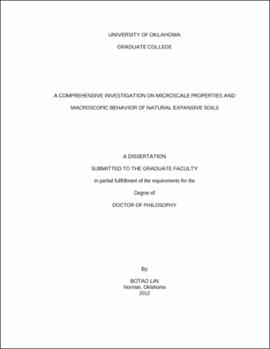| dc.contributor.advisor | Cerato, Amy B | |
| dc.creator | Lin, Botao | |
| dc.date.accessioned | 2019-04-27T21:35:19Z | |
| dc.date.available | 2019-04-27T21:35:19Z | |
| dc.date.issued | 2012 | |
| dc.identifier | 99318234002042 | |
| dc.identifier.uri | https://hdl.handle.net/11244/319087 | |
| dc.description.abstract | Understanding the complicated behavior of expansive soil requires in-depth exploration of microscopic phenomena under varying situations, especially when the soil stays unsaturated and experiences swell-shrink cycles. This study is dedicated to a comprehensive investigation of eleven micro-scale properties that function as revealing factors of these electro-physico-chemical mechanisms and the associated surface forces. These microscale properties include: specific surface area (Sa), cation exchange capacity (CEC), surface conductance (λddl), soil acidity (pH), mineralogy (from X-ray diffraction), structure (from scanning electron microscopy), elemental composition (from energy-dispersive X-ray spectrometry), diffuse double layer thickness (t), real relative permittivity (κ'), effective conductivity (σ) and suction (s). Four naturally collected and two laboratory stabilized expansive soils were selected as the study objects. The roles of some microscale properties in determining the macroscopic behavior of volume change and shear strength have been thoroughly examined through experimental work including three dimensional water content-volume-suction studies and a triaxial test program on unsaturated specimens along three capillary paths. The effects of chemical stabilization by fly ash have also been extensively evaluated from a microscopic point of view. | |
| dc.description.abstract | Some innovative testing and analysis approaches were proposed; highlights include (1) constructing a two-terminal electrode system integrated in conventional oedometer equipment and performing dielectric measurements on natural expansive soils at various hydromechanical stages; (2) quantifying diffused double layer (DDL) in terms of thickness and surface conductance; (3) establishing an unsaturated triaxial testprogram based on the predetermined hysteretic soil water characteristic curves (HSWCCs) and the chilled mirror hygrometer tests after shear. Additional newly developed approaches were applied in the studies of soil mineralogy, structure and pore fluid (e.g., assessment of the degree of interfacial polarization and the electrical anisotropy). | |
| dc.description.abstract | This research establishes a comprehensive framework of expansive soil behavior based on experimental efforts and analysis founded in geology, geochemistry, electronics and geomechanics. The outcome will not only help field engineers explain and find solutions for natural threats on civil infrastructure caused by expansive soils, but also provide evidence and a database for verification or improvement of the present geophysical and mechanical constitutive models. Some potential research efforts, especially the imaging of intact soil structure and the adoption of dielectric testing as a common geotechnical practice, are suggested based on the findings of this study. | |
| dc.format.extent | 201 pages | |
| dc.format.medium | application.pdf | |
| dc.language | en_US | |
| dc.relation.requires | Adobe Acrobat Reader | |
| dc.subject | Swelling soils | |
| dc.subject | Soil physics | |
| dc.subject | Environmental chemistry | |
| dc.title | A Comprehensive Investigation on Microscale Properties and Macroscopic Behavior of Natural Expansive Soils | |
| dc.type | text | |
| dc.type | document | |
| dc.thesis.degree | Ph.D. | |
| ou.group | College of Engineering::School of Civil Engineering and Environmental Science | |
